Furthermore there will be different version of the main client depending on how you logged in. Here is a list of planned main client types:
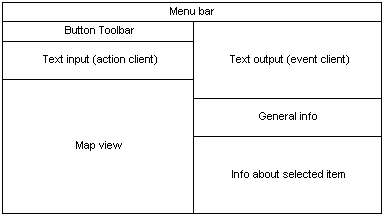
The menu bar contains menus for all possible operations. The button toolbar contains "shortcuts" to frequently performed operations, or operations that must be performed quickly (for example "flee"). This will include an inventory button which has dual purpose. When clicked it will produce a floating inventory window, and when an item is dragged to that button it will be added to the inventory. Or something like that.
The Text input area is a text component that allows the user to type actions. Most or all actions should be possible to perform using text when desired. See "action client" below for more details. The Text output area is where the system sends messages to the player. Most of these messages will be descriptions of events that occur in the world. Only events that cannot be described graphically should be displayed here. See "event client" below for more details.
General info is a general purpose panel that displays static information about the world relevant to the current context of the player. During outdoor travel it might include weather information, while in combat it would display the most important combat attributes, such as the player's HP...
Info about selected item is a general purpose property-panel. It show information about the currently selected item. The main difference between this and the general info panel is that the player controls what is displayed in this panel. See "property client" below for more details.
The Map view displays the character's current location and which other objects are nearby.
The player client will map some global keys as well, for certain frequently performed actions. So far now only one is specified:

This is where the user specifies, using text, which action to perform. Whenever ENTER is pressed, the last typed line will be executed. Queries can also be performed here, and may in some cases spawn external windows. The exact set of actions is not defined yet, but here are some examples:
In order to minimize unnecessary typing, a number of "smart" shortcuts will be available here. First of all, "frequently used" commands will have shortcut representations. "say", for example, might replaced by a simple ".", and "emote" might be replaced by a ":". Here is a list of other "shortcut" features (of which several are stolen from UNIX...):
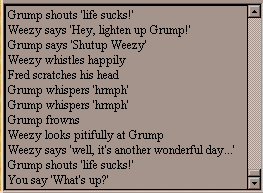
This displays information from the system to the player, usually an event report (as in the screenshot above). As specified earlier, all words representing items will be highlighted in a different color, indicating that they can be manipulated with the mouse. This window does not accept text input.
Note that only events that aren't suitable for other mediums will be displayed here. If a sound file is available for a certain sound, for example, that will be used instead of describing the sound in the event window.
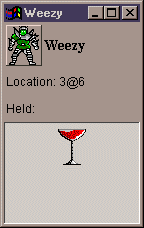
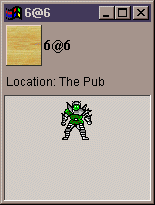
Above are two property clients - one for Weezy the Orc, showing his location and inventory, and one for the place represented by coordinate 6@6 in the Pub, and it's contents.
Property clients are very generic - each type of object provides it's own type of property client adapted to it's own needs. In fact, the server creates the property window on the fly. All the values in the property client are dynamically updated when the value changes. If input facilities are provided, the input is directed straight to the server. All icons and words representing items provide the usual set of item operations.
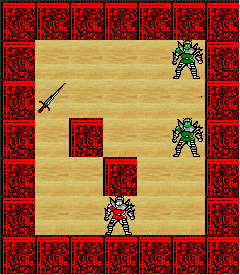
A map client shows the contents of a given place, and may be constrained to the field-of-view of a character (ie if it is dark most of the map will be dark as well). Normally this will take the form of a rectangular grid of items as shown above, but in some cases it may look different (for example if the character is inside a bag it might just show what other objects are inside the bag). When several items are located in the same square, only one will be shown (the "topmost", ie the one judged to be of most direct interest). Clicking on this item will select it. Clicking again on the square will instead select the actual square (in a player client the rest of the contents of the square will be visible in the property window). Each click will switch between selecting the item and the selecting the square containing the item.
Last updated: